- It's difficult to predict when the first house would be swallowed
- Residents who want to see the lava would be taken to a safe distance
Are you affected by the lava? Share your images and stories with CNN iReport, but only if it is safe to do so.
Pahoa, Hawaii (CNN) -- The thick, fiery stream of lava oozing over eastern Hawaii is about to cross Pahoa's main street and could soon envelop over a dozen homes.
As the fire danger increases, 80 members of the Hawaii National Guard will start patrolling road blocks Thursday.
 Chasing the lava in Hawaii
Chasing the lava in Hawaii 
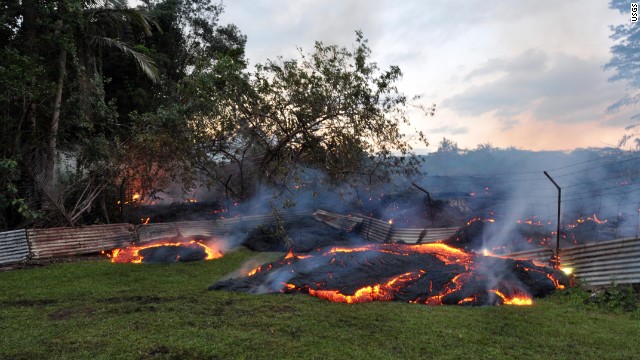 Lava burns vegetation as it approaches a property boundary early on the morning of Tuesday, October 28. A lava flow from the volcano Kilauea is advancing on the community of about 950 people on Hawaii's Big Island. By early Tuesday, the flow was about 70 yards (64 meters) from the closest home and moving to the northeast at 8 to 11 yards (7-10 meters) per hour, the Hawaiian Volcano Observatory said.
Lava burns vegetation as it approaches a property boundary early on the morning of Tuesday, October 28. A lava flow from the volcano Kilauea is advancing on the community of about 950 people on Hawaii's Big Island. By early Tuesday, the flow was about 70 yards (64 meters) from the closest home and moving to the northeast at 8 to 11 yards (7-10 meters) per hour, the Hawaiian Volcano Observatory said. 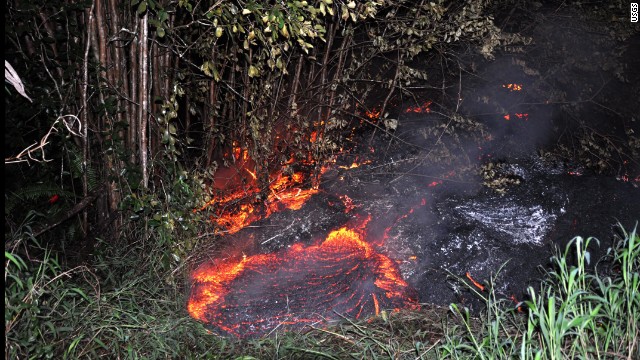 Pictured here on Tuesday morning, October 28, lava had crossed into two privately owned properties.
Pictured here on Tuesday morning, October 28, lava had crossed into two privately owned properties.  Smoke rises near Apa'a Street and Pahoa Village Road in Pahoa, Hawaii, on Monday, October 27.
Smoke rises near Apa'a Street and Pahoa Village Road in Pahoa, Hawaii, on Monday, October 27. 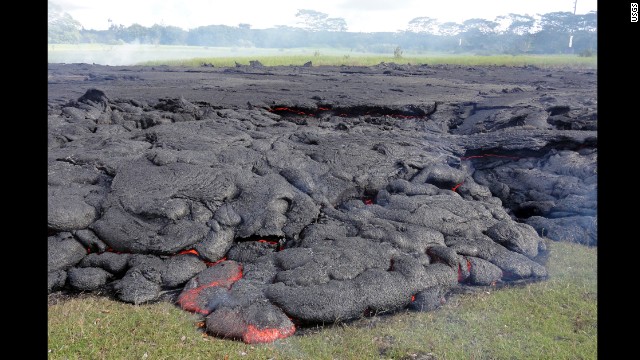 The horizontal incandescent cracks seen in the center and right portions of the photo, taken October 25, indicate that the flow was inflating: Fed by a continuing supply of lava beneath the cooling crust, the surface slowly rises.
The horizontal incandescent cracks seen in the center and right portions of the photo, taken October 25, indicate that the flow was inflating: Fed by a continuing supply of lava beneath the cooling crust, the surface slowly rises. 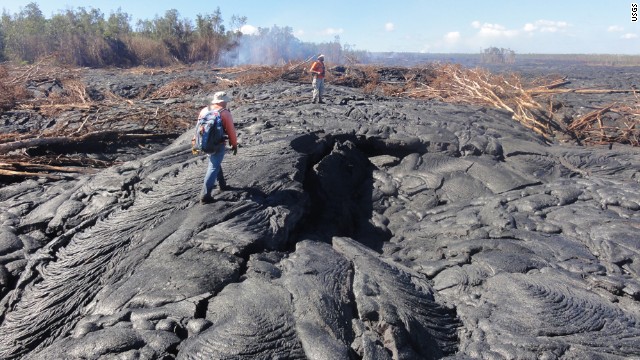 Hawaiian Volcano Observatory geologists walk over the surface of the flow to track surface breakouts along a portion of the flow margin, about a kilometer (0.6 miles) up the slope from the flow front, on October 24.
Hawaiian Volcano Observatory geologists walk over the surface of the flow to track surface breakouts along a portion of the flow margin, about a kilometer (0.6 miles) up the slope from the flow front, on October 24.  Another view of the leading tip of the flow as it moves into the open pasture on October 24.
Another view of the leading tip of the flow as it moves into the open pasture on October 24.  Pu'u O'o Crater, in the eastern rift zone of Kilauea, remains filled with thick fumes, but recent views with the naked eye and thermal camera confirm that little change has occurred in the crater over recent weeks. The fumes mask a handful of small, glowing openings on the crater floor.
Pu'u O'o Crater, in the eastern rift zone of Kilauea, remains filled with thick fumes, but recent views with the naked eye and thermal camera confirm that little change has occurred in the crater over recent weeks. The fumes mask a handful of small, glowing openings on the crater floor.  A closer view of surface activity on September 15. "A lot of smoke (is) coming off the front, a lot of cracking noises, methane explosions are going on," said Tim Orr of the U.S. Geological Survey (USGS). "So, it's a noisy situation out there just from all the burning vegetation."
A closer view of surface activity on September 15. "A lot of smoke (is) coming off the front, a lot of cracking noises, methane explosions are going on," said Tim Orr of the U.S. Geological Survey (USGS). "So, it's a noisy situation out there just from all the burning vegetation."  A view of the sinuous, channelized flow that was moving to the northeast from Kilauea on June 27. The flow threatening Pahoa has advanced about 13 miles (21 kilometers) since then. Kilauea is one of the world's most active volcanoes.
A view of the sinuous, channelized flow that was moving to the northeast from Kilauea on June 27. The flow threatening Pahoa has advanced about 13 miles (21 kilometers) since then. Kilauea is one of the world's most active volcanoes.  Lava crawls from Kilauea
Lava crawls from Kilauea 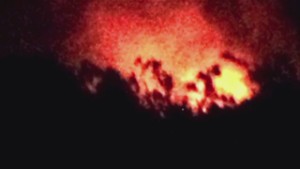 Up close as lava inches towards homes
Up close as lava inches towards homes 
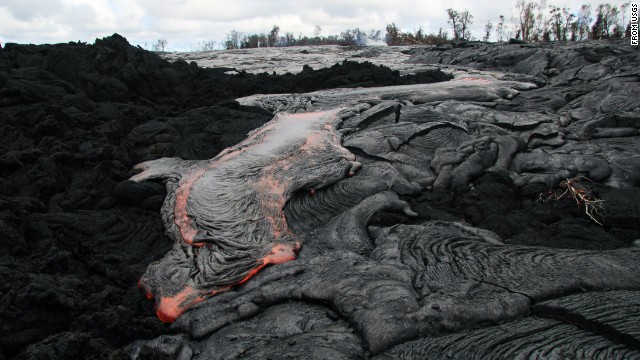 Lava flows from the Kilauea volcano October 3 in Pahoa, Hawaii. The flow has recently picked up speed, prompting emergency officials to close part of the main road through town and tell residents to be prepared to evacuate.
Lava flows from the Kilauea volcano October 3 in Pahoa, Hawaii. The flow has recently picked up speed, prompting emergency officials to close part of the main road through town and tell residents to be prepared to evacuate. 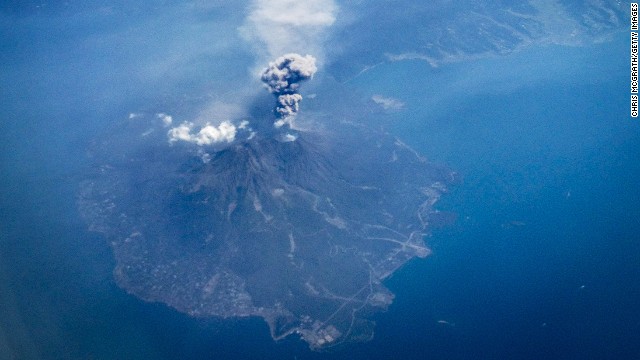 Japan's Mount Sakurajima erupts on September 29. It was the second volcano in two days to erupt in Japan.
Japan's Mount Sakurajima erupts on September 29. It was the second volcano in two days to erupt in Japan.  Dense white plumes rise high in the air as Mount Ontake erupts in central Japan on September 27.
Dense white plumes rise high in the air as Mount Ontake erupts in central Japan on September 27. 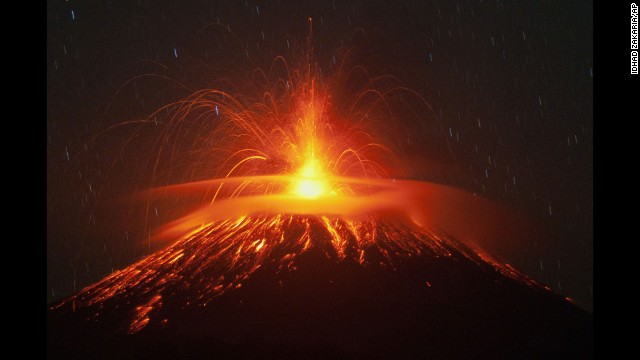 Mount Slamet spews lava and gas during an eruption in Brebes, Indonesia, on September 18.
Mount Slamet spews lava and gas during an eruption in Brebes, Indonesia, on September 18.  Fountains of lava spurt from a fissure in the ground on the north side of the Bardarbunga volcano in Iceland on September 2.
Fountains of lava spurt from a fissure in the ground on the north side of the Bardarbunga volcano in Iceland on September 2. 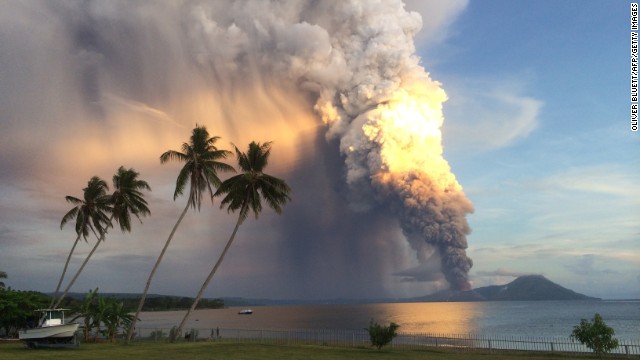 Mount Tavurvur erupts August 29 in eastern Papua New Guinea, forcing local communities to evacuate and international flights to be rerouted.
Mount Tavurvur erupts August 29 in eastern Papua New Guinea, forcing local communities to evacuate and international flights to be rerouted.  The Tungurahua volcano, as seen from Ambato, Ecuador, spews a column of ash on April 4. The volcano emitted a 6-mile-high column of ash after a powerful, five-minute explosion that shot pyroclastic material onto its northern and northwestern flanks. The volcano has been active since 1999, with several major eruptions in that span.
The Tungurahua volcano, as seen from Ambato, Ecuador, spews a column of ash on April 4. The volcano emitted a 6-mile-high column of ash after a powerful, five-minute explosion that shot pyroclastic material onto its northern and northwestern flanks. The volcano has been active since 1999, with several major eruptions in that span.  A villager in Karo, Indonesia, bathes in a river while Mount Sinabung erupts, spewing lava and giant clouds of ash on January 21.
A villager in Karo, Indonesia, bathes in a river while Mount Sinabung erupts, spewing lava and giant clouds of ash on January 21. 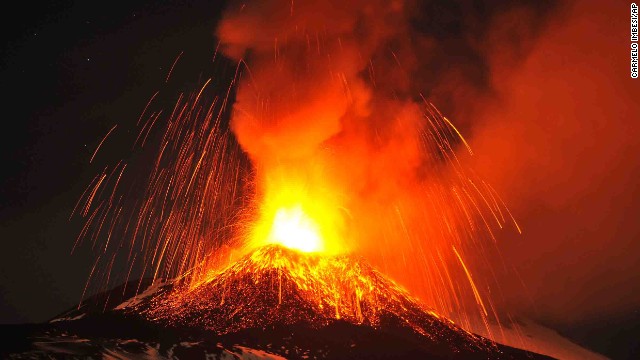 Mount Etna, as seen from the town of Acireale, Italy, spews lava during an eruption on November 16.
Mount Etna, as seen from the town of Acireale, Italy, spews lava during an eruption on November 16. 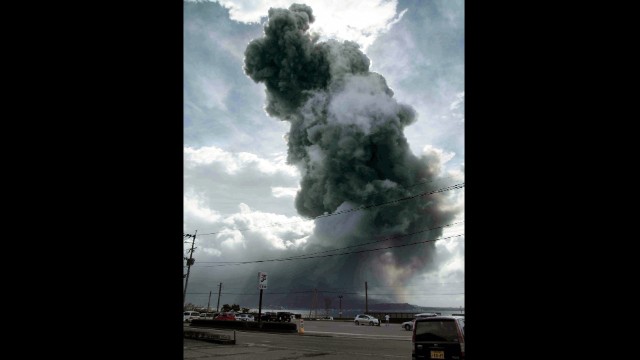 Smoke and ash spew from Mount Sakurajima, in Kagoshima, Japan, on October 7, 2013.
Smoke and ash spew from Mount Sakurajima, in Kagoshima, Japan, on October 7, 2013.  Lava from the Puu Oo cone of the Kilauea volcano reaches the Pacific Ocean on the southeastern coast of Hawaii Island in January 2013. Puu Oo has been erupting for more than 30 years. This eruption, on the volcano's east rift, began in January 1983.
Lava from the Puu Oo cone of the Kilauea volcano reaches the Pacific Ocean on the southeastern coast of Hawaii Island in January 2013. Puu Oo has been erupting for more than 30 years. This eruption, on the volcano's east rift, began in January 1983.  The Karymsky volcano erupts in Kamchatka, Russia, in January 2013.
The Karymsky volcano erupts in Kamchatka, Russia, in January 2013.  The Copahue volcano emits smoke and ash above Caviahue, in Argentina's Neuquen province, in December 2012.
The Copahue volcano emits smoke and ash above Caviahue, in Argentina's Neuquen province, in December 2012. 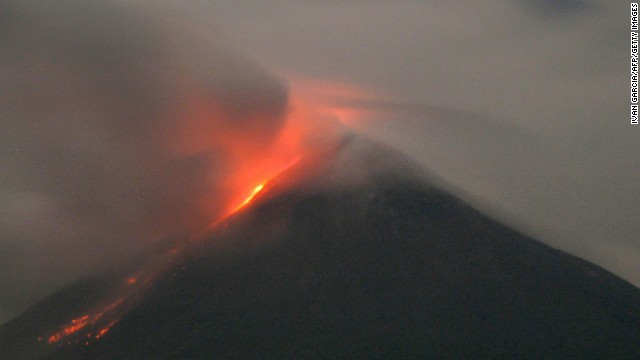 Western Mexico's Colima volcano emits lava in October 2004. The Global Volcanism Program reported "a bright thermal anomaly" as well as gas emission in November 2013.
Western Mexico's Colima volcano emits lava in October 2004. The Global Volcanism Program reported "a bright thermal anomaly" as well as gas emission in November 2013. Recently active volcanoes
Recently active volcanoes
Recently active volcanoes
Recently active volcanoes
Recently active volcanoes
Recently active volcanoes
Recently active volcanoes
Recently active volcanoes
Recently active volcanoes
Recently active volcanoes
Recently active volcanoes
Recently active volcanoes
Recently active volcanoes
Recently active volcanoes
 Photos: Recently active volcanoes
Photos: Recently active volcanoes The slow-moving stream has been inching along at about 30 feet per hour, said Darryl Oliveira, director of the Hawaii County Civil Defense.
Late Wednesday, the nearest home was about 100 feet away from the liquid inferno. But due to shifts in the lava's speed, it's difficult to predict when the first house would be swallowed.
About 20 families in the path of the lava have been told to evacuate, Oliveira said Wednesday.
The main road in Pahoa, on Hawaii's Big Island, will be overcome with lava by Friday morning. While the front of the lava flow is 15 feet wide, the molten river widens significantly behind it, the U.S. Geological Survey said.
"As it moves across soil, you can hear and smell the fire," said Troy Scott of the Hawaii County Civil Defense Agency. "It is incredibly hot ... the heat is very strong."
What to know about volcanoes
Watching for 'closure'
Scott said residents who want to see the lava move over the community would be taken to a safe distance "to allow them to have their closure."
"We're going to be very sensitive to the fact that they'll be losing their home, and this would be a catastrophic event," Scott said.
The slow-moving lava flow began moving toward Pahoa in June, when a volcanic crater vented and released the river of liquid rock.
And it could go much longer. A USGS geologist said the lava flow could continue for 30 years.
CNN's Martin Savidge reported from Pahoa; Holly Yan reported and wrote from Atlanta.
No comments:
Post a Comment